How Deep Is Your Love
The Bee Gees (’77) & Calvin Harris + Disciples (‘15)
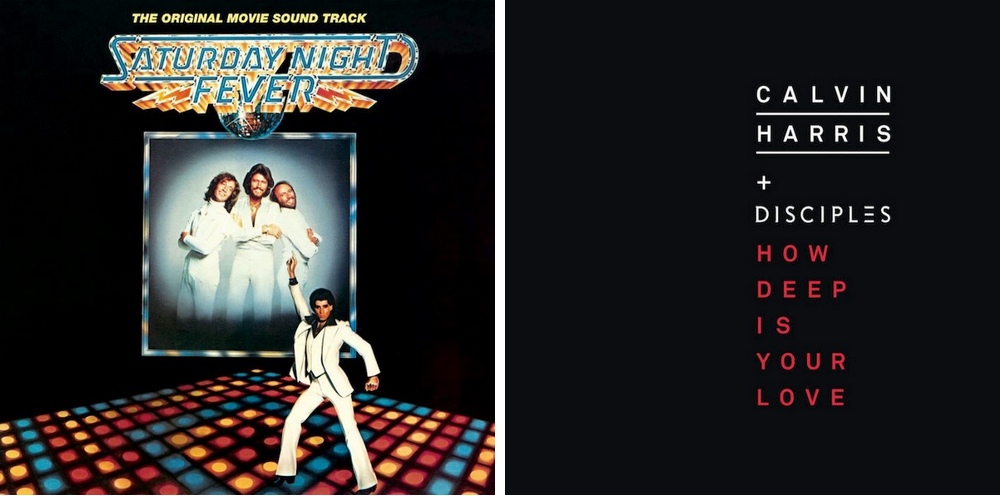

The Bee Gees’ “How Deep Is Your Love” was released in September of 1977 as a single, then later included on the Saturday Night Fever soundtrack. It was the first of six consecutive Bee Gees’ singles to hit #1. FunFact! It's Barry Gibb’s favorite Bee Gees song.¹
It’s also a good example of a hard-to-pin-down radio category called “Middle of the Road.” MOR isn’t genre-specific, but you definitely know an MOR station when you hear one (think: supermarkets). This comment sounds disparaging, but I love this song — The Bee Gees’ 70s output is basically unimpeachable in my book: Classic 70s dry production, the ABBA-sized vocal harmonies, the juicy harmonic twists and turns… what’s not to love?²

There’s a few notable things here: both the prechorus and chorus are unusual lengths. The prechorus flows like 4 bars followed by a 2 bar turnaround, and during this turnaround we get a bit of an arrangement breakdown where the synth in the right channel gets a moment to shine. The prechoruses end with the first harmonized “How deep is your love?” which bleeds over smoothly into the chorus.
The odd lengths of these sections feel natural because they’re working in service to the vocal part. The lyrics of this song are worded conversationally, and the melodic writing and accompaniment work in conjunction with each separate linguistic statement — so the extra bars don’t stick out, because they are (in effect) used to finish a sentence.
The song has super fancy chord progressions. The chorus is: [Eb > EbM7 > AbM7/Eb > Ab°7 > Eb > Eb7/Db > C7 > Fm > Abm > Eb] …and once again we get the classy melodic b9 on the C7 “they should all just let us be,” which resolves romantically to the pivot chord Fm. The 3rd verse (sung in “La-La-La”) functions like a bridge, but contains no additional musical changes. This is a good call, because the harmonic motion is so smooth that having a specific BRIIIDGE! moment (See: Bryan Adams) might kill the vibe.
This song is anchored by a luscious rhodes piano (with full-on 70s phaser) and a standard rhythm section; but the instrumentation builds over time, eventually involving both acoustic and electric guitars, strings, an acoustic piano, and subtle synth pads; all topped with an army of breathy overdubbed vocals. To give you an idea of how thick this arrangement is, here’s a chart for the first chorus:
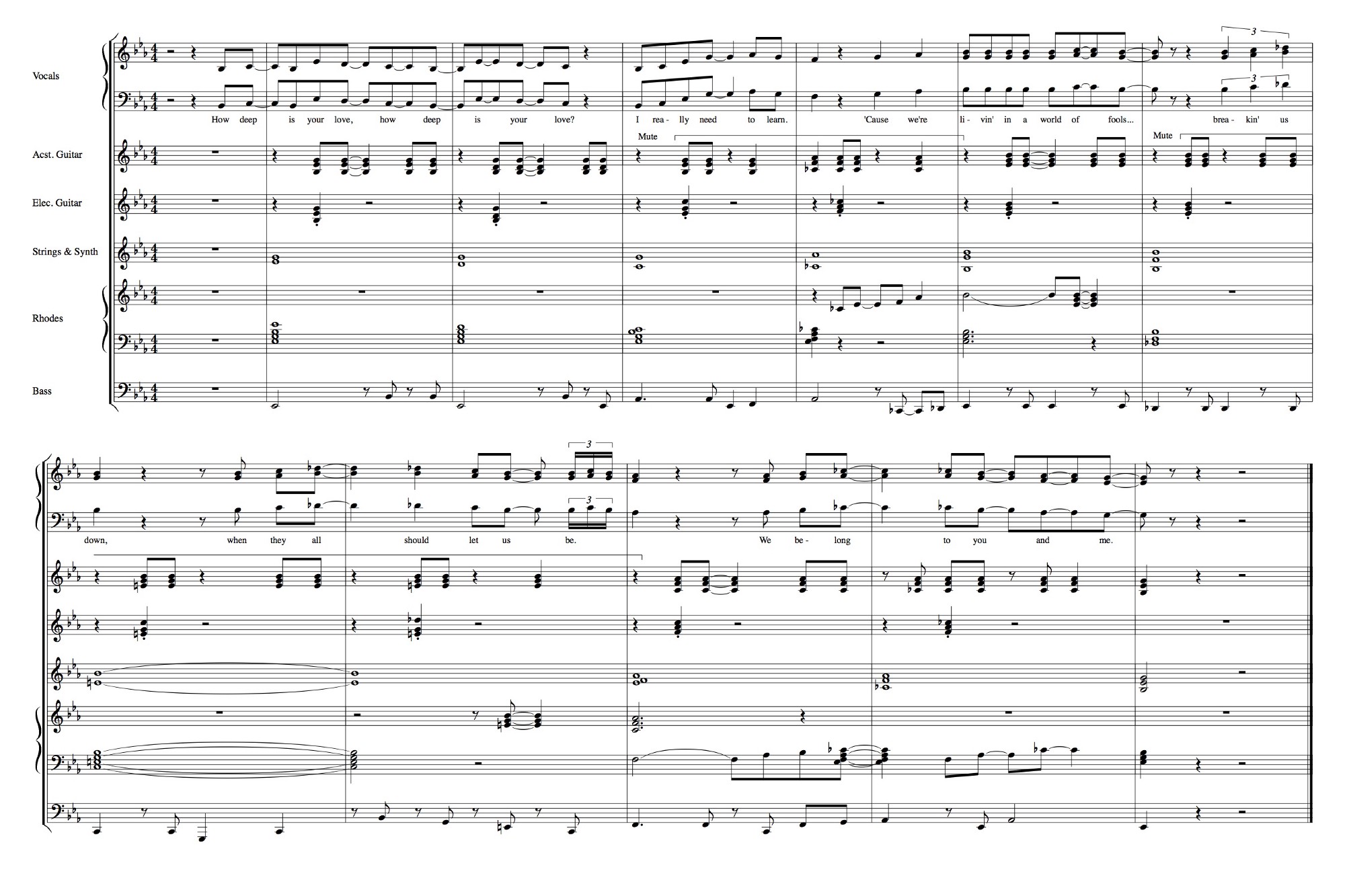
…And later choruses include a bunch of additional melodic lines in the strings, and more active comping from the rhodes.
Clever and unusual mix choices help to clarify this overfull arrangement: there’s a bunch of manual panning and volume shifts throughout the whole song, the rhodes piano and strings wander all over the stereo field and take the center when they have lead lines (such as the 2nd verse and the string part in the ending double chorus). Instead of changing the drum part to kick up the intensity for the choruses, the acoustic guitar in the left channel gets a bump; and the guitar part includes non-chord strums and muted lines for extra emphasis.³
Despite its density, the backing track never quite hits anything over a mf, and I think much of this song’s success comes from the dynamics and expression being largely relegated to the vocal performances.
And these 👏 vocal👏 performances👏 are👏 great.👏 There’s a rich level of expressiveness in the dynamics and linguistic phrasing — even if a modern listener will need to forgive some of the more parody-able delivery choices. For example, the first prechorus (“You come to me like a summer’s breeze / Keep me warm in your love / then you softly leave”), starts in a straightforward pure tone, before hitting a Michael McDonald-esq melisma, and finally softening into a breathy diminuendo, all in the space of 4 measures.
From the perspective of a modern pop producer, the direction would likely be to “tone it down on all the vocal stuff and stay focused” — but man, do they pull these (now somewhat bizarre seeming) vocal components together into a great song-length narrative. It’s also a good example of how multitracked vocals don’t always have to reach the pyroclastic intensity of Queen, or the 10-million-voices-strong production of ABBA to still function effectively… as long as the vocalists who are multitracking are all on the same page with regard to how the arsenal of vocal techniques can be deployed in order to deliver the lyrics in a particularly unified way.⁴
The singles from Calvin Harris’ first album (titled — amazingly — “I Created Disco,” 2007) were some of the first songs I remember specifically finding out about through the relatively new site YouTube. This first album is full of tongue-in-cheek lofi indie pop jams. I didn’t keep track of him in the interim… and 5 years later, when the singles from “18 Months” started demolishing the UK charts, they wound up at the office for transcription. Having not kept up with Harris, I was quite surprised to find him now a clean-cut Serious Young Man, producing radio-focused EDM.
I had to look “DISCIPLΞS” up on Wikipedia. They’re an English house production trio who’s been active since 2013. They’ve done a track with David Guetta. That’s all I got.⁵
Calvin Harris & Disciples’ “How Deep Is Your Love” is a house-leaning EDM tune featuring vocals from London-based Norwegian vocalist Ina Wroldson. Harris has become one of the most consistently commercially successful EDM producers over the last few years… but like a lot of chart-topping EDM artists, his tracks tend to get major side-eye from critics, who often cite their self-similarity. As a transcriber, I can confirm that these sentiments are basically true from a technical and structural perspective — but this is largely missing the point.⁶
Electronic music often organizes its genres around incredibly specific production and writing features, such as a single drum break, tempo ranges, or a even a particular filter effect… so in this regard, I think many detractors are basically cherry picking these similarities in Harris’ tracks simply because they don’t emotionally connect with the material.⁷
With all of that said: this song is a very by-the-numbers Pop EDM tune, which hits all of the formal requirements: A hooky repeated vocal sample, sparse verses, the buildup and drop, etc.

This structure is a mix of pop and dance songforms, and we essentially get 2 separate choruses: a vocal chorus, and the drop (which functions more like a traditional chorus, but is largely instrumental). Like most radio-friendly EDM, the sections are delineated primarily by production features and the vocal phrasing rather than discrete harmonic changes.
This song is in E minor, but Harris & Disciples do something interesting: they begin the song with a sustained C in the bass, giving the opening sections a dreamy, mysterious C Lydian flavor — or, coupled with the melodic A, sort of an Am+6/C feel.
Aside from the verses, this trick is also used in the buildups. The rest of the song just jams away on variations of [ i > VI > iv > iv ]. Here’s The Drop:
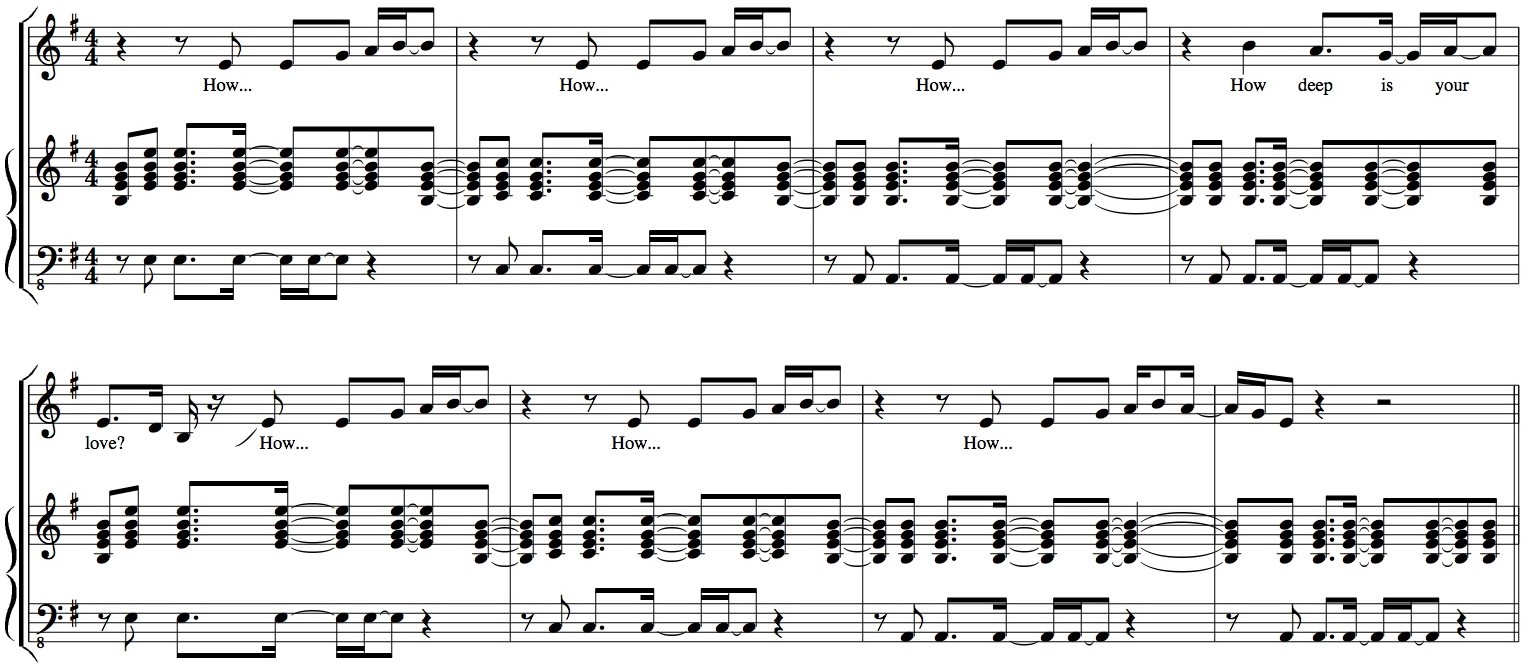
One of the key features which gives this track a nod to the “house” camp is, of course, the Korg M1 piano. The M1 piano is a hallmark of many iconic tunes from the 90s, across both underground and DJ-focused tracks, and massive pop hits. Funfact! the M1's slap bass sound is not only featured in the Seinfeld intro, but was also digitized for the SNES’ built-in slap bass sound.
Likewise, the syncopation used in this house piano riff is right in the pocket for this style. Rhythmically, the bass does some interesting stuff: beginning the phrase on the 1& instead of 1 makes for a nice feeling of moving into beat 2; and the bass rest on beat 4 leaves the low-end of the track clear for the kick and clap on 4, and the 1 of the following measure.
Throughout the song, there’s quite a bit of variation in the production of the drums. There are a few different kick samples and filter treatments of each, we get a short, midrange-focused Kwnp in the verses, and a rounder, low-endy Kbwuompf in the buildups and chorus.⁸
The lyrics to this song are pretty, uh… focused?
How deep is your love?
How deep is your love?
So tell me how deep is your love, can we go deeper?
So tell me how deep is your love, can we go deep?
So tell me how deep is your love, can we go deeper?
So tell me how deep is your love, can we go deep?
(How deep is your love?)
So tell me how deep is your love, can we go deeper?
So tell me how deep is your love, can we go deep?
(How deep is your love?)
So tell me how deep is your love, can we go deeper?
(Pull me closer, again)
So tell me how deep is your love
How deep is your love?
How deep is your love?
How deep is your love?
So tell me how deep is your love, can we go deeper?
So tell me how deep is your love, can we go deep?
(How deep is your love?)
So tell me how deep is your love, can we go deeper?
So tell me how deep is your love, can we go deep?
We do get some shading in the verses, which are comprised of somewhat abstract requests from the narrator to the subject using I/You pronouns. These lines are set quite nicely against the aforementioned mysterious C Lydian feel, and their brevity and disconnected syntaxes support a linguistic meandering around the diction of sensual experience.
Whereas the Bee Gees elaborate a bit more on the nature of the narrator and subject’s relationship (with lines eluding to the outside world’s disapproval), in Harris’ & Disciple’s tune, the textual elements are relegated exclusively to the internal forces of the relationship itself — most broadly couched in a simple, insistent demand for the knowledge of a love’s depth, or perhaps more broadly, it’s character.
Whatever those dimensions or features are, though, we the public are left only to wonder. It is the question itself which holds the weight in this piece.
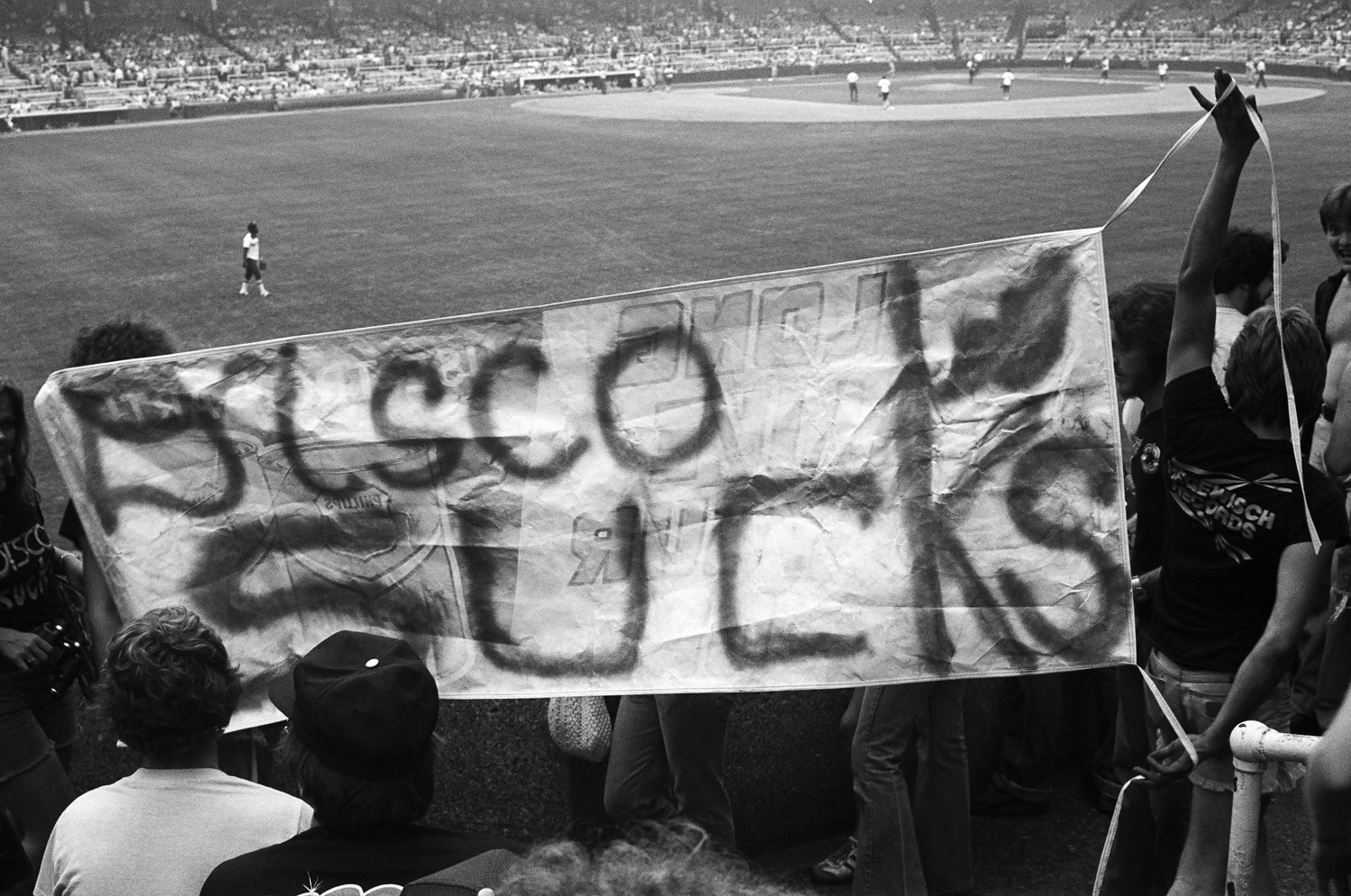
July 12th, 1979 in Chicago Illinois, the crowd at the Comiskey Park was at capacity, with an additional 20,000 people milling about, unable to enter through the now-locked gates. Many of these folks, however, were not here for the Tigers/White Sox double header — but for the promotional event scheduled for between the two games.
This, of course, was Disco Demolition Night.
Many modern commentators on Disco in the 70s point to this event — which also provided a kind of (literally) explosive megaphone to the “Disco Sucks!” movement’s coded racist and homophobic sentiments, which these days might be a bit more media-savvy and “dapper” — as the beginning of the end for Disco’s celebratory, free-wheeling nightlife scene.
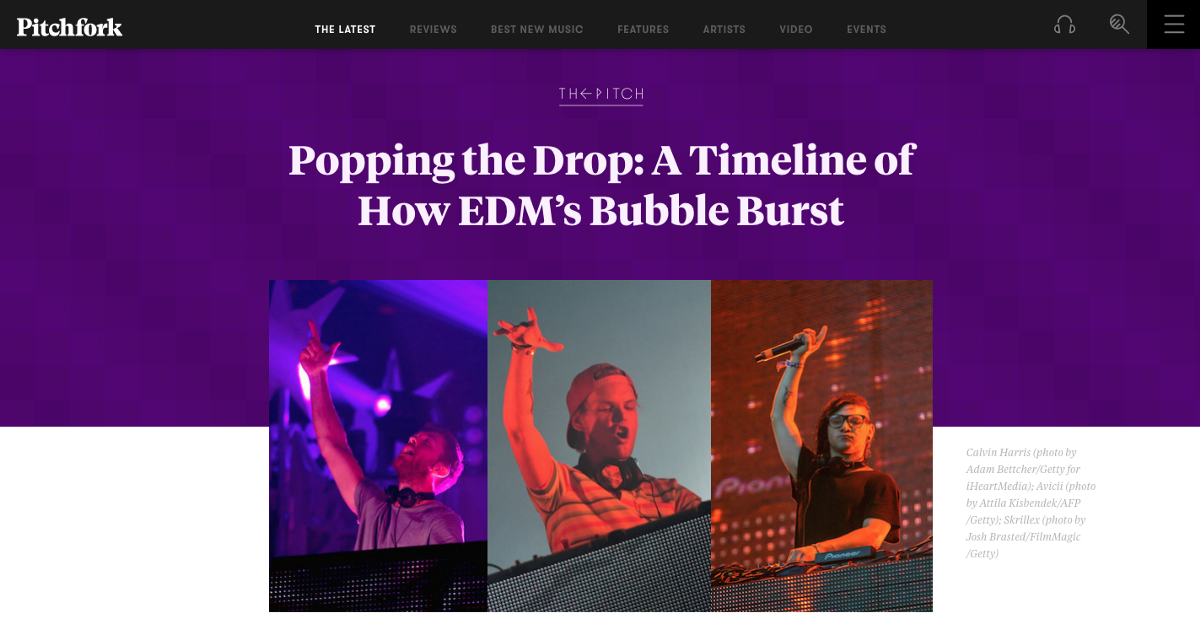
For the last several years, a running thread in certain music crit n’ biz circles has been the “bursting of the EDM bubble.” Some commenters have pointed to Tropical House as essentially being EDM’s version of MOR. In the later article, the interviewer asks weather recent pop EDM is “courting a more ‘adult’ audience,” and in response the interviewee discusses the product tie-ins of recent pop EDM videos as “icky” and uses the phrase “parental-approved EDM”… it’s hard not to read the word “sucks” between the lines here.
However, neither of these two reports is suggesting that next year you won’t be able to switch on Spotify, YouTube, etc. and hear nary an EDM tune — that’s just not how it works any more. The bottom may fall out of the ticket-buying market for EDM festivals, but from a broader marketing standpoint, personal tastes are no longer required to fit into homogenized categories in order to be monetized by media companies.
Additionally, the current “Curatorism” production phase we’re now enjoying ensures that there will be plenty of musicians producing whatever kind of music you like, no matter how obscure, unfashionable, or commercially untenable.
Disco didn’t die when a stadium full of knuckleheads blew all them records up. Yes, Discoteques around the nation found themselves going out of fashion — which had tragic and far-reaching effects for the socially inclusive communities which they welcomed and supported. But disco-flavored production simply adapted to different sorts of pop writing, bending to mesh with other pop styles in the 80s. A worldwide top-10 EDM song like Calvin Harris’ “How Deep Is Your Love” can trace its DNA through a wiggly lineage straight back to artists like Frankie Knuckles, Moroder, and The Bee Gees. In 2017, even if “the EDM bubble” bursts, all you have to do is wait a few years for it come back around.
No type of pop music dies any more — even if you want it to.
[2] KOIT (96.5 FM) is the Bay Area’s reigning MOR station. “K-O-I-Teeee… KOIT!! Ra-di-ooo~~~” With that said, the buyout/closure of KISS FM earlier this year was a bummer; it was bar-none my favorite drivetime station, and got me through many 4pm traffic jams. :(
[3] In 1977, panning and volume changes probably would have been performed live when bouncing multitrack reels down to stereo tracks. The slang for this is “Riding the faders.”
[4] Bonus: Here’s an great live recording. they’ve transposed the tune to allow for an additional upper vocal harmony, which gives the chorus an almost country flavor.
[5] They’re on the record label FFRR… not to be confused with PFFR.
[6] Calvin Harris broke Michael Jackson's record for most UK top 10 singles to chart from a single album.
[7] See: The Amen Break and The Wubz.
[8] Are these onomatopoeia helpful? Should I stop doing this? It’s really hard to describe stuff like kick sounds in text. Maybe I should start embedding audio from SC? That would be really time consuming, though. I’m open to suggestions.